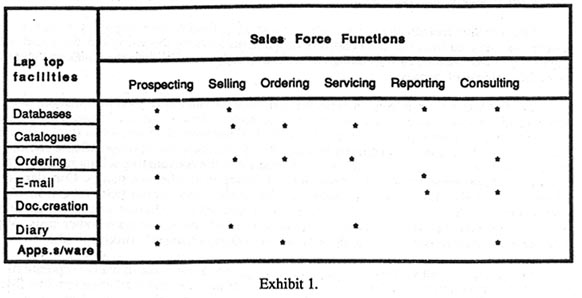
Evaluando el Impacto de un Proyecto de Automatización de Ventas
Blaise Cronin and Elisabeth Davenport
Department of Information Science
University of Strathclyde
Glasgow G1, Scotland, UK
Abstract: A Fortune 500 computer vendor commissioned us to study the likely impacts of salesforce automation on its UK operations. The objective was to establish a before and after position to enable the company to qualitatively and quantitatively measure the resultant business benefits. Our findings are based on an empirical analysis of how the salesforce used information, not on preconceptions about the assumed benefits of automation.
Typical salesforce functions are prospecting, selling, ordering, servicing, reporting and consulting. How can laptop computers add value to these activities? By providing remote access to company databases and catalogues, by facilitating online ordering and status reporting, by offering electronic diary, e-mail and document creation facilities, plus a range of applications software (from spreadsheets to personal data management packages). Laptops are a means of overcoming the tyranny of distance and of ensuring that information on customers, major accounts, products, prices, competitors, techno-logy trends and institutional memory is effectively disseminated and exploited.
The effects of automation are both short and long-term. We analyzed the ripple effects in terms of six key variables: time management; quality of corporate communications; knowledge management structural reconfiguration motivational factors; cultural reper-cussions. The study suggests that the effects of salesforce automation will be multi-dimensional, impacting on sales performance, quality of service and corporate culture, and that traditional approaches to cost-benefit analysis may not be adequate when applied to strategic IT investments of this kind.
Resumen: Una de las compañías Fortune 500, dedicada a la venta de computadoras, nos comisionó para estudiar los efectos de la automatización en los vendedores de la compañía y el impacto sobre sus ventas en el Reino Unido. El objetivo del estudio fue establecer a priori y a posteriori una posición que permitiera a la compañia medir cuan-titativa y cualitativamente los beneficios resultantes de sus operaciones. Nuestros resul-tados están basados en un análisis empírico de cómo los vendedores utilizan la informa-ción, no sobre preconcepciones de los supuestos beneficios de la automatización.
Las funciones típicas de los vendedores son de tipo prospectivo, de ventas, servicio, de comunicación y de asesoría. De qué manera las computadoras portátiles pueden agregar valor a estas actividades? La respuesta es la siguiente: proporcionando acceso, a control remoto, a las bases de datos y catálogos de la compañia, facilitando los pedidos en línea y el estado de los mismos, ofreciendo la agenda electrónica, correo electrónico y las facilidades necesarias para la elaboración de documentos, además de una gran varie-dad de aplicaciones del 'software' (desde hojas de cálculo hasta paquetes de administra-ción de información de tipo personal). Las computadoras portátiles representan el mejor medio para vencer la tiranía de la distancia y asegurar que la información sobre los clientes, las cuentas principales, productos, precios, competidores, tendencias tecnoló-gicas y memoria institucional sea efectivamente diseminada y explotada.
Los efectos de la automatización son a corto y a largo plazo.
Nosotros analizamos los efectos de las ondas de acuerdo con las siguientes
seis variables principales: administra-ción del tiempo, calidad
de las comunicaciones internas, administración del saber cómo,
reconfiguración estructural, factores de motivación y repercusiones
culturales. El estudio sugiere que los efectos de la automatización
sobre los vendedores serán multidimen-sionales, ejerciendo impacto
sobre sus ventas, calidad del servicio y la cultura de la empresa, También,
que la orientación tradicional del análisis costo-beneficio
puede no ser el adecuado coanto se aplique a inversiones estratégicas
en la tecnología de la información.
Salesforce automation impacts on the marketing function in different ways. At the strategic level, the marketing cycle in an organization may be modelled in terms of an information chain which ensures that input, processing and outputs are attuned to the external environment. Such tuning requires an integrated and complete knowledge base which permits linkages between the phases of the cycle (Shaw and Stone, 1989). The laptop computer has an important part to play in closing the loop, as it allows field intelligence to be rapidly relayed to the central base for analysis and subsequent application to whatever area is relevant (Stanat, 1989).
At the tactical level, marketing information is collected to support distinct functions (procure-ment; research and development; lead qualification; order support). Technology allows the sales-force reliable and immediate access to information on the state of affairs in different functional areas (current book orders, stock position, hot prospects). Such a facility can be crucially impor-tant in the field, and has been a major driver of laptop automation programmes.
At the personal level, salesforce automation can build up confidence, impart a sense of comfort and strengthen the conviction behind salestalk. All of these are soft, or intangible, bene-fits, which are often not taken into account. In the study which we describe below, however, these loomed large in the comments of our interviewees at whatever level in the company.
2. A CASE STUDY
A Fortune 500 computer vendor commissioned us to study the likely impacts of salesforce automation on its UK operations. Our remit was to establish a before and after position to enable the company to qualitatively and quantitatively measure the resultant business benefits. The findings are based on semi-structured interviews with a sample of earmarked early adopters. In our interviews we posed the following questions:
• What do you do?
• Where does the time go?
• What are your information inputs/outputs?
• What do you hope to be able to do with your laptop?
• What benefits do you expect?
The company had already successfully automated its field service engineers in the UK. Our sample was selected from the first cohorts to be automated among the salesforce. Most had not attended a formal training course, though some had already received their machines and were using them for a variety of purposes.
Our findings emerged from an exploration of how the salesforce used information, not from preconceptions about the assumed benefits of automation. Most of our interviewees were aware of the company's salesforce automation project in the US, but were skeptical when shown figures which measured alleged improvements in productivity and corporate revenues. Some could, how-ever, see how laptops might enhance their performance in the consultative selling process. This has, in fact, been one of the drivers of salesforce automation in other companies: Chrysler, for example, has "a vision of the way we wanted to change the culture of our field force: from clerical people who went around and picked up sales reports and orders, to business consultants. So we didn't try to justify the expense based on man-power reductions or savings on other costs. We did it because we were trying to change the way we were doing business" (Brody, 1988).
Marketing and sales productivity (MSP) networks are a live issue in many corporations, as integration encourages mutual feedback in all domains of the sales and marketing function (Meikle-john, 1989). Closing the loop between marketing campaigns and sales was a major objective for our clients, who themselves act as consultants to other companies in this area (Automation..., 1989). We raised this broader context in our discussions of the likely impacts of automation; several interviewees, however, had no perception of the big picture, preferring to see themselves as independent operators. The automation project could be expected to broaden their perspective.
3. SALESFORCE FUNCTIONS / LAPTOP FACILITIES
The matrix in Exhibit 1 classifies salesforce functions under six primary headings: pros-
pecting, selling, ordering, servicing, reporting, consulting (Meikle-john, 1989). We feel this
sextet comprehensively covers the spectrum of sales activities, from qualifying initial leads through to consultative selling.
This array is set against seven generic facilities which might be made available via laptops:
• databases
• catalogues
• ordering
• document creation
• diary
• application software
These emerged from our request for a "shopping list" of desirable features. The asterisk indicates likely areas of impact, i.e. where a particular facility contributes to a specific function. Some facilities will impact more widely than others; databases, for example, can contribute to four of the functional activities. Laptops can facilitate access to an expanded range of corporate data-bases on products, customers, competitors and industry trends.
The matrix is a simple instrument which enables managers of automation projects to prioritize

facilities for resource allocation. It could, however, be refined by gathering additional feedback from the salesforce as a project rolls out. The present version is tentative, but we feel that such a matrix would have value as a predictive tool, when based on a more robust and representative sample. We therefore suggest that an audit mechanism be a feature of the software packages which are initially offered. This would help to identify anchor applications and assess the value-in-use of different facilities.
Exhibit 2 offers a taxonomy of the information used by the salesforce within the company. It was compiled on the basis of our previous knowledge of the information resources and processes which are available within the marketing and sales division, and on the basis of comments made in interviews. Some information assets were under-exploited; several interviewees were, for exam-ple, unaware of the existence of Kompass online within the company. One claimed that as far he
was concerned "competitive data doesn't exist yet"; another questioned the etiquette of logging on
and accessing such data in front of a client. Other facilities, like the Personal Librarian retrieval package, were about to be released on a trial basis. Some existed in dispersed paper format. Ulti-mately, the laptop project would allow the salesforce to tap into the full array of marketing and sales-related databases throughout the UK and Europe.
There was an expressed demand for electronic access to what we called "catalogues" (e.g. price lists, product lists, phone numbers) and for functional information ("ordering") in the form of order status reports or configuration options. One salesman wanted to see configuration linked online to a telex quotation system. These were areas where the interviewees expected immediate and measurable benefits: for example, improved accuracy and timeliness of information. Equally important, though less tangible, was credibility with the customer; delays and errors mean dissa-tisfied customers who may transfer negative feelings from service to products.
Given the importance attached to profit improvement
plans within the consultative selling framework, we recommended that the
company should consider an electronic archive of this
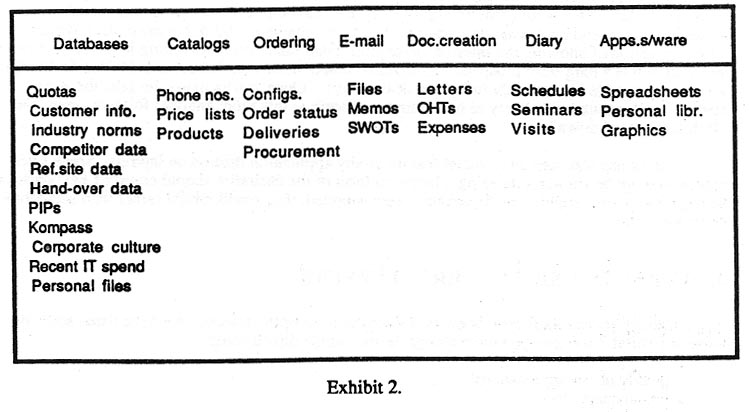
material, which would allow others to analyze and benefit from recorded experience ("leveraging off one another's effort", as one salesman put it). One district was introducing a hard copy version of shared experience relating to the defence/aerospace sector in the form of a booklet which pro-filed past selling successes worldwide. One interviewee hoped to see such information extended via the laptop project: "It's upsetting when success goes unrecorded". Such information on key selling factors gives credibility in front of clients; "not shooting from the mouth, but shooting from experience".
Most of our interviewees were troubled by the hemorrhaging of expertise at "hand-over" time, when one salesman replaces another as site representative: at most both reps might visit a site for an hour together. The replacement has to go through his own learning process, building up a dossier of contacts and general intelligence on the customer. Laptop access to a predecessor's files could save considerable duplication of effort and soften the learning curve. Company information (e.g. recent IT spend; corporate culture/ethos; procurement practices) featured high on the "wish list". Protracted analysis was not what was required; one interviewee suggested S.W.O.T. flashes on customers and competitors (i.e. real-time, single screen digests of strengths, weaknesses, opportunities and threats), which would be used to identify potential high yield customers and blind spots in competitors. The usefulness of company information was variable: "oily rag" com-panies are less likely to require analysis than "bumbling great giants". Such information would be used indirectly, as it is company policy "to sell on company strengths, rather than competitor weaknesses".
Mail generation was a major headache for many of those interviewed. Letters were produced manually or submitted in draft form via e-mail to secretaries, and this could result in "a delay of three to five days". Laptops would allow salesmen to prepare their own correspondence and free up secretarial time for more substantive tasks, such as large-scale report generation. In certain selling environments, the telephone is likely to remain the primary technology. One member of the salesforce involved in strategic selling did not need laptop capability which offered immediate ordering or configuration facilities; the telephone was adequate for his needs.
Voice input could conceivably assume an important role in trapping details of successfully completed deals. This would require highly structured data input, voice recognition capability and subsequent back-end processing/integrating. Such a mechanism would, for example, have the added attraction of allowing the salesman to exploit "dead time" while travelling in his car to/from a site visit, but is a long-term prospect. It should be noted, however, that some salesmen feel analy-sis is inappropriate immediately following deal closure: "Once you've made the sale, the work starts". Implementation is likely to be a primary concern at this time; analysis follows when "the affair has cooled down".
Ease of use was seen as a crucial feature of any application offered on laptops. Some sales-men would not be comfortable using a laptop in front of the customer should complex keyboarding be required. If over-sophisticated packages were supplied, they could inhibit rather than accelerate early adoption.
4. IMPACTS / SHORT-TERM EFFECTS
Automation has short-term impacts and longer-term ripple effects. We have listed some of these in Exhibit 3 and grouped them alongside six change dimensions:
• quality of communications
• time management
• knowledge management
• structural
• motivational
• cultural
The benefits of change in each of these dimensions will vary; some will be measurable in quantitative terms, others will have qualitative effects. Some will be essentially business/corporate benefits; others will be manifested in improved personal efficiency/job satisfaction.
Improved quality of communications was identified as an important personal benefit. The immediacy of contact which laptops provide would significantly reduce "dead time" in several key contexts (e.g. lead qualification; order enquiries; coordinating schedules for seminars, presenta-tions and training programmes) by eliminating "telephone tag", double-bookings and so on. To quote one of the interviewees, "dead time becomes thinking time". Improved time management was another expected benefit. All of those interviewed envisaged shifts in home/office work ratios, and in customer/colleague contact ratios. These ratios can be quantified and mapped, and we produced Exhibit 4 on the basis of rough estimates from our interviewees of where time cur-rently went and where it was likely to go post-implementation.
Input from the salesforce into the marketing function was a radical change made possible by automation. Previously, such field information had not been systematically or comprehensively trapped within the company. The exchange of significant and timely detail would be of immediate practical advantage and would remove the "Chinese walls" which inhibit lateral information flows between those handling comparable deals/accounts in different sales regions. Such information aggregates into shared know-how/know-who, and offers obvious corporate benefits. By any rec-koning, field information is an invaluable component of the marketing information loop.
A salesforce requires competitor and client information which can be rapidly ingested and easily digested. The applications offered via laptops must meet these criteria. Existing centralized databases/services were said by some to "proliferate work" and "generate huge amounts of rub-bish", which seemed to indicate a need for systems which could filter, discriminate and customize. The improved knowledge management capability offered by laptops can free up time for higher level tasks, thus restructuring the value of salesforce (and support) activity.
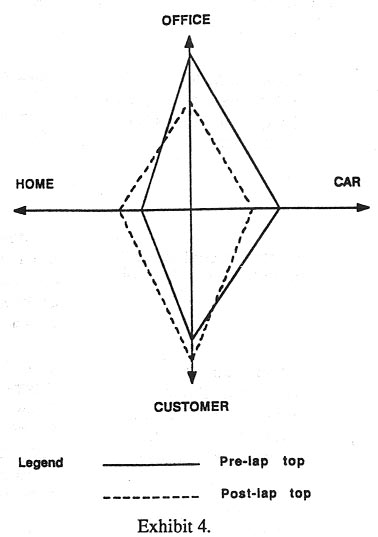
Some of those interviewed had positive views on the sharing of locally gathered customer information (electronic aides memoire covering four or five key points). Such "odds and ends" ("Where did we leave off last time?" ... "How is his daughter doing at university?" ... "Which applications is he currently thinking about?") could be used to flesh out impersonal customer information and be the basis of more finely focussed mail shots. They would in addition be useful at hand-over time, when potentially valuable expertise might not be transferred: the official proce-dure relied heavily on written files, but most salesmen had "a mental not a written picture" of their accounts.
We identified a number of structural repercussions, in terms of both physical and human resources. The need for fixed individual desks will decline as demand for general and contingent meeting space grows (the virtual "office of the future"). However, the efficiencies which we predicted for progressive office bypass were considered ambivalent: some face-to-face contact was held to be important, especially in the context of spotting talent and grooming it for advancement.
Automation was seen as a positive and desirable development: in addition to the enhanced productivity which we outlined, softer benefits were envisaged in terms of effective customer contact and enhanced credibility. The phrase "conviction selling" was used to convey the sense of increased confidence and self-esteem conferred by laptops; "comfort factor" was also used in this context: "If I haven't got too much to talk about, I've always got my laptop as a conversation point".
Two salesmen operating at the strategic level, were particularly conscious of the impact of laptops on company image: "BMWs, "board rooms" in local offices, laptops are all part of a $10 billion company image" which would impress the "thoroughbreds of management" who were their contacts within key accounts. Others felt that laptops might be seen as a gimmick; instruction in the etiquette of laptop usage (when to use/not use) should thus be a feature of any corporate training programme.
5. RIPPLES / LONG-TERM EFFECTS
The net effect of improved quality of communications will be reduced cost per order dollar (CPOD), as finely honed information on suspects, prospects and customers passes efficiently to and from the salesforce through the marketing loop. Targeting thus becomes standard practice, and this ramps up the ratio of deals to leads. A long-term consequence of improved order processing may be migration to EDI (electronic data interchange), which will shorten cycles by eliminating links in the traditional order chain. Some customers may favour teleordering for routine pur-chases, which will free up salesforce time for higher value consultative selling.
Time switching, or liberation from standard office hours, will have far-reaching effects on both personal productivity and quality of working life. One of our interviewees, perhaps atypical as his responsibilities had a European dimension, envisaged "a massive reshaping in workstyle and a major shift in loci operandi ".
An integrated marketing knowledge base would be a strategic asset. Whereas a salesman might quarry this resource to make a one-to-one comparison to solve a specific problem, marketing specialists could use it to identify underlying patterns or trends; the factors that relate to deal failure, for instance, could be extracted and used for training purposes.
We think that persistent office bypass possibly raises long-term asset management issues. The "office" will become essentially a utility unit serving the company's sales network, with gradually declining occupancy levels (because of increased home and site-based work) and a higher proportion of technical support staff (for network management). Access to integrated information systems will allow more members of the salesforce to emigrate to the sites of their major accounts; in this way consultative selling is effectively transformed to in-house consultancy.The long-term effects of improved self image, public image, stress reduction and other personal "comfort factors" could add up to a significant corporate benefit, as employee satisfaction will be reflected in reduced turnover/attrition.
6. HARD AND SOFT BENEFITS
In the previous two sections we have spotlighted salient impacts, short-term and long-term. These are summarized in Exhibit 5 under three headings:
• culture
• quality of service
• salesforce effectiveness
Associated with each of these categories are hard
(quantitative) and soft (qualitative) benefits. We attempted to classify
some of the prospective benefits in Exhibit 6 in terms of their position
on the hard-soft spectrum. The bottom line criteria remain those of CPOD
and quotas. Other benefits
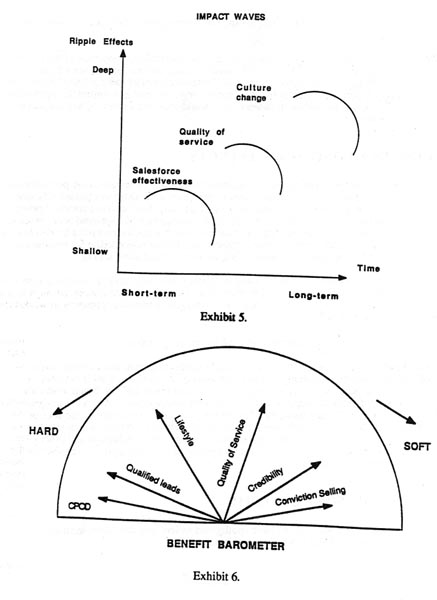
must be assessed in terms of their leverage effect on these two fundamental measures. How does credibility impact the bottom line? The approach used by the company in the evaluation of its US salesforce automation exercise was to track increases in selling time and the percentage of sales reps over quota in both the pilot and control groups. This approach could be refined by splitting the pilot group into "positives" (those claiming enhanced esteem) and "neutrals" (who make no claims to increased credibility). The subsequent quota performance of each sub-population would then be compared. Customer feedback might also serve as a measure of credibility. Existing survey instruments could be modified to incorporate direct and/or oblique questions relating to critical deal closure factors (e.g. sales rep efficiency, technical competence, presence, confidence).
7. SUMMARY
Our brief was to identify measurable business benefits
(quantitative and qualitative). We illustrate in Exhibit 7 how benefits
can be positioned in a two dimensional space, which maps
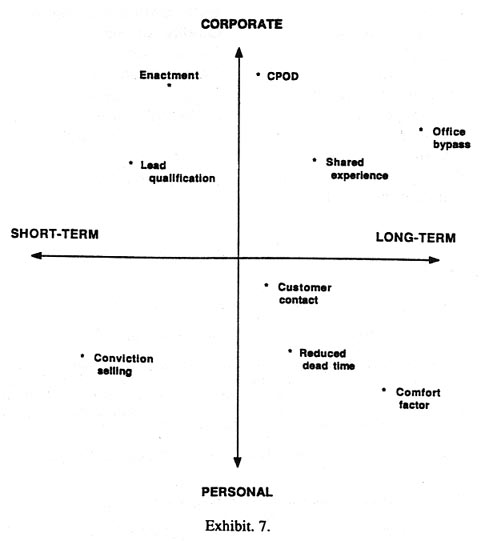
short-term/long-term and personal/corporate benefits. The initial classification which we offered at the beginning of this paper (strategic, tactical, personal) was based on our reading in this area. However, our field study suggested that strategic benefits had the lowest priority and that personal and tactical gains were more likely to influence adoption. Exhibit 8 offers a division into "hard" and "soft" benefits: the former, the tactical benefits, are relatively easy to quantify, but the assessment of soft factors is more subjective and impressionistic. Just which of these measures deserve closest attention will only emerge from post-implementation interviews, when actual and expected benefits can be distinguished.
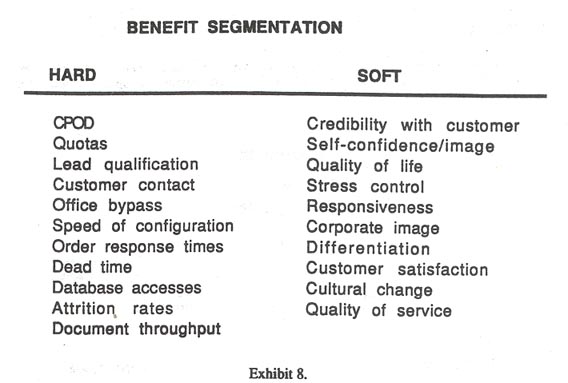
REFERENCES
"Automation goes into marketing," Business Directions, May/June 1989, 35.
Brody, M., "Laptop computers stand tall at last," Fortune, 28 March, 1988, 87-90.
Meiklejohn, I., "Window on the sales world," Management Today, July 1989, 113, 116. See also additional sources including: Ferreira, J. and M. E. Treacy, "It's more than just laptops," Datamation, November 1, 1988, 127-131. Rawstorne, P. Sketchley, "golden egg," Financial Times, 25th May, 1989. Moriarty, R.T. and G. S. Swartz, G.S., "Automation to boost sales and marketing," Harvard Business Review, January-February, 1989, 100-108.
Poppel, H. L. and B. Goldstein. Information Technology: The Trillion Dollar Opportunity. New York: McGraw-Hill, 1987. pp. 23-25.
Shaw, R. and M. Stone. Database marketing. Aldershot: Gower, 1989.
Stanat, R. E., "Field sales intelligence systems,"
In Proceedings of the Tenth National Online Meeting, New York, May 9-11
1989. Medford, NJ: Learned Information, 1989. pp. 413-422.